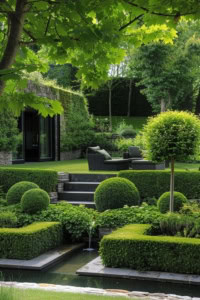The Appeal of Green on Green Landscapes
The allure of green on green landscapes lies in their simplicity and sophistication. By using multiple shades of green, from deep emerald to soft sage, you can create a monochromatic palette that feels both cohesive and dynamic. This approach allows for a seamless integration of different plant species, each contributing its unique texture and hue to the overall design.
One of the key benefits of this trend is its versatility. Green-on-green landscapes can be adapted to various styles, whether you prefer a modern, minimalist look or a more traditional, cottage-like feel. The use of diverse textures, such as the feathery fronds of ferns, the broad leaves of hostas, and the fine needles of conifers, adds depth and interest to the landscape without overwhelming the senses.


Creating Depth and Interest with Textures
Incorporating different textures is crucial to achieving the full effect of a green-on-green landscape. Textures create visual interest and prevent the monochromatic scheme from becoming monotonous. Here are some ways to blend textures effectively:
- Layering Plants: Start with a variety of plant heights and structures. Use tall, leafy trees and shrubs as the backdrop, mid-sized plants like hydrangeas or azaleas in the middle, and ground covers such as moss or creeping thyme at the forefront. This layering technique adds depth and creates a natural flow.
- Mixing Leaf Shapes: Combine plants with different leaf shapes and sizes. The large, bold leaves of elephant ears can contrast beautifully with the delicate, lacy foliage of maidenhair ferns. This interplay of shapes enhances the overall texture of the landscape.
- Incorporating Evergreens: Evergreens are a fantastic way to maintain year-round interest. Their varied textures, from the dense, needle-like leaves of pines to the soft, cushiony mosses, provide a rich tapestry of green that remains vibrant even in the colder months.
Practical Tips for Incorporating Green on Green Landscapes
To successfully incorporate the green-on-green trend into your landscape, it’s essential to plan thoughtfully and consider the specific conditions of your space. Here are some practical tips to get you started:
- Assess Your Space: Evaluate the amount of sunlight, soil type, and moisture levels in your garden. Choose plants that thrive in these conditions to ensure a healthy, sustainable landscape.
- Use Green Structures: Incorporate green elements beyond just plants. Green walls, living fences, and trellises covered in ivy or climbing plants can add vertical interest and texture.
- Consider Maintenance: While a green-on-green landscape is visually stunning, it can also require regular upkeep. Select low-maintenance plants if you prefer a garden that’s easier to care for, and consider automated irrigation systems to keep your plants lush and hydrated.
- Work with Professionals: Designing a green-on-green landscape can be complex, so don’t hesitate to seek professional help. At AquaTerra Outdoors, our experienced team can assist you in creating a design that not only looks beautiful but is also practical for your specific needs.
The green-on-green landscapes trend is a testament to the timeless beauty of nature’s most abundant color. By focusing on various shades and textures of green, you can create a landscape that feels both tranquil and invigorating. Whether you’re starting from scratch or enhancing your existing garden, incorporating this trend can transform your outdoor space into a lush, verdant paradise. Contact AquaTerra Outdoors today to explore how we can help you bring this beautiful trend to life in your backyard.